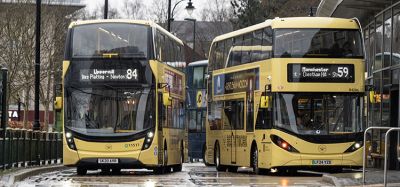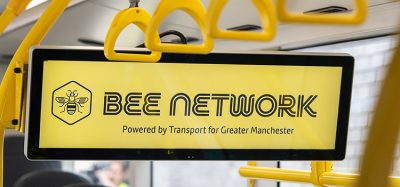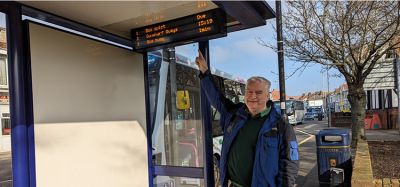A partnership working in practice
- Like
- Digg
- Del
- Tumblr
- VKontakte
- Buffer
- Love This
- Odnoklassniki
- Meneame
- Blogger
- Amazon
- Yahoo Mail
- Gmail
- AOL
- Newsvine
- HackerNews
- Evernote
- MySpace
- Mail.ru
- Viadeo
- Line
- Comments
- Yummly
- SMS
- Viber
- Telegram
- Subscribe
- Skype
- Facebook Messenger
- Kakao
- LiveJournal
- Yammer
- Edgar
- Fintel
- Mix
- Instapaper
- Copy Link
Posted: 11 November 2008 | Chris Spry, Senior Transport Planner, Oxfordshire County Council; Tim Wood Senior Site Engineer, ACIS and Brian Riley, Area Team Leader, ACIS | No comments yet
Like all cities, Oxford faces constantly changing transport challenges. Economic and housing growth in the south east of England are creating new pressures and adding to existing transport problems in and around Oxford. The County Council’s role is to respond to these pressures to ensure the city’s economy and communities continue to thrive, whilst protecting and enhancing its unique environment.
The county and city councils have consistently taken a joint approach to tackling Oxford’s transport challenges – it was one of the first cities in the UK to adopt a traffic restraint policy and abandon road building as a solution to its transport problems.
Like all cities, Oxford faces constantly changing transport challenges. Economic and housing growth in the south east of England are creating new pressures and adding to existing transport problems in and around Oxford. The County Council’s role is to respond to these pressures to ensure the city’s economy and communities continue to thrive, whilst protecting and enhancing its unique environment. The county and city councils have consistently taken a joint approach to tackling Oxford's transport challenges – it was one of the first cities in the UK to adopt a traffic restraint policy and abandon road building as a solution to its transport problems.
Like all cities, Oxford faces constantly changing transport challenges. Economic and housing growth in the south east of England are creating new pressures and adding to existing transport problems in and around Oxford. The County Council’s role is to respond to these pressures to ensure the city’s economy and communities continue to thrive, whilst protecting and enhancing its unique environment.
The county and city councils have consistently taken a joint approach to tackling Oxford’s transport challenges – it was one of the first cities in the UK to adopt a traffic restraint policy and abandon road building as a solution to its transport problems.
This approach began in the early 1970s with the adoption of a Balanced Transport Policy for the city – an integrated approach which included the development of an extensive Park & Ride system, parking controls and extended cycle and pedestrian facilities. It continued in the early 1990s with the adoption of a comprehensive strategy following a study undertaken by Colin Buchanan and partners.
This ‘pro-bus’ policy created the foundations for a core commercial network in the greater Oxford area with high modal share for public transport. The two major operators in Oxfordshire – Stagecoach in Oxfordshire and Oxford Bus Company (OBC, part of the Go-Ahead Group) are in competition on a number of key city routes.
In 2002, political leaders promoted the implementation of a real time information system with reference to the broader Oxford Transport Strategy and Local Transport Plan objectives, in particular to support improvements to bus patronage by making public transport a more attractive travel. RTI was anticipated to bring the following benefits:
- Improvements to actual timetable adherence and thus reliability
- Enabling operators to manage their fleets more efficiently and therefore allowing them to match demand and supply more effectively within a given level of resource
- Providing reassurance to passengers, empowering them to make decisions about their journeys.
- Increasing the convenience of bus use by enabling users to check the availability of a service before proceeding to the bus stop
Despite Oxfordshire failing in a bid to the Department of Transport, Local Government & The Regions (DTLR) for central government funding in 2002, further feasibility work was commissioned through Halcrow Group Ltd to scope system requirements, UK best practice and potential cost implications. Critically, Stagecoach & OBC actively contributed to discussions on funding, maintenance and technical requirements, thus enabling the County Council to propose a tendering exercise for a limited pilot on the high-frequency bus corridor between Oxford & Kidlington with both operators willing to contribute to initial scheme costs.
This corridor was chosen principally because it was believed that high levels of on-road competition would provide a challenging environment to test the system’s robustness whilst the operators could improve bus reliability in the area through use of system monitoring tools. The pilot would also benefit a large number of users on more of the UK’s busiest corridors (buses up to every 2 to 3 minutes).
A tendering exercise commenced in 2003 with Advanced Communication & Information Systems (ACIS) eventually being identified as a preferred supplier in early 2004. Halcrow provided assistance through tender evaluation to award following approval by County Council cabinet for a trial incorporating 20 on-street displays, 74 AVL equipped vehicles, website, operator monitoring tools and PMR (Private Mobile Radio) system infrastructure. Importantly, the contract included system expansion options whilst committing ACIS to deliver improvements consistent with Real Time Information Group (RTIG) standards, thus enabling the system to grow organically in line with new developments.
The initial trial costs of £458,000 were shared between the County Council, Stagecoach and OBC with subsidiary agreements detailing maintenance responsibilities for different asset categories and also valid use of RTI data – e.g. for congestion monitoring and to identify locations where ACIS traffic signal priority equipment could be installed.
The County Council launched the Real-Time Information (RTI) system in April 2004 in partnership with The Oxford Bus Company, Stagecoach and ACIS. Initially, ACIS was unable to meet the objective of delivering a working system by the end of 2004. Both ACIS and the County Council recognised the need to deploy more resources to ensure delivery of project objectives. ACIS restructured its operations, creating roles for Senior Site and Field Engineers – locally based staff responsible for effective system management, whilst Halcrow retained an advisory role through testing to final system sign-off in April 2006. Officers within the County Council ensured robust day-to-day project & data management in this initial phase, thus allowing the authority to take full responsibility for the system in the longer term.
The Oxfordshire RTI system has since expanded and now incorporates 254 equipped buses, split between three operators – Oxford Bus Co (152), Stagecoach in Oxfordshire (86) and Thames Travel (16). ACIS also provides radio communications for the Oxford Bus Co fleet with a 2-way voice facility from a computer aided dispatch.
Public information services are provided through on-street LED displays, plus the www.oxontime.com website, and a Short Message Service (SMS) interface. The project partners chose to provide the SMS facility at ‘minimum’ cost to the user – currently a maximum of 12p for a return text. Text codes are displayed via the website, at-stop and on operators publicity.
The website now receives 50,000 visits per annum with similar levels of usage for text messaging – student take-up has been significant although further marketing campaigns are planned to target the growing commuter market between surrounding towns such as Witney and Oxford. Again, a partnership approach is demonstrated in the ways in which the www.oxontime.com website is branded in a ‘neutral’ manner to stress the project’s shared ownership.
ACIS provides the system utilising trunked Private Mobile Radio (PMR). The central Oxfordshire radio hub site is located at Boar’s Hill. The radio base site is used to control the logging of vehicles onto the system and the sending and receiving of data messages. All calls are routed via the hub to enable the system to perform inter-site voice and data calls. A second base site is located at Brentford to track the Oxford Bus Company coach fleet running to London Victoria, Heathrow & Gatwick airports. With the further expansion of the system, a further base site has been commissioned at Woodcote in the south-east of the County (July 2008) with a fourth base site scheduled in 2008 in the Great Tew area covering north Oxfordshire. It is hoped that such comprehensive radio coverage will assist in the GPS tracking of rural routes operated by smaller companies such as Thames Travel, in addition to providing more accurate Real Time Information in market towns such as Chipping Norton, Banbury and Wallingford.
Vehicles are tracked via satellites using Automatic Vehicle Location (AVL) technology with ADSL communication links in place between the ACIS server and Oxfordshire County Council (OCC), Oxford Bus Company (OBC) and Stagecoach in Oxfordshire console terminals. These allow control staff to monitor and dynamically manage their respective fleets in ‘real time’, and to revise timetable schedules over the course of time. Access to a software package called ‘Operator Reports’ permits OCC officers to analyse journey times for particular stops/routes, informing the design of highway and bus priority schemes and assisting in bus punctuality monitoring.
The ACIS (Mistral) system server is based in Docklands, Canary Wharf, London and handles the real time data from the vehicles, tracks the vehicles and holds the systems configuration. The Servers are used to store the historical information from which operator reports can be generated – including the schedules and network information used to configure the system. The COM system facilitates two-way communication – forwarding data between PMR base station at Boars Hill and the main ACIS server (Mistral) through a VPN line and to Stagecoach, Oxford Bus Co and Thames Travel via dedicated kilostream lines. The system also provides for continuous data updates to Stagecoach/OBC/TT Console machines and to the base site via kilostream lines. The same data is supplied to OCC’s Console in Speedwell House through the local TCP/IP network.
The COM system is currently hosted by OCC on a server based in Oxford. The current COM set-up tools allow for remote diagnostics and fault rectification during periods of disruption and messaging of signs and website displays using the Speedwell Console. The Console software is in the process of being upgraded to a web version Vehicle Viewer. Both Stagecoach and OBC are independently responsible for facilitating migration to Vehicle Viewer software through installation of their own broadband links etc.
Currently, the Oxfordshire RTI system has 92 on-street displays all showing real-time (as opposed to timetabled) predictions from the ACIS RTI system, with a further 71 displays scheduled for installation this financial year, bringing the total of real time information displays to 163 by March 2009. Displays are located at Park and Ride sites, bus shelters and freestanding flag displays along routes throughout Oxford City Centre and Oxfordshire towns and villages. Further installations are planned for key rail station interchanges, new shopping, retail and housing developments.
The system is maintained by the ACIS local engineer team with an Area Team Manager, Senior Site Engineer, Field Service engineer and Configuration engineer, an additional resource of nine engineers in the region can be called upon to assist in Oxford as and when required.
The County Council has recently appointed a dedicated member of staff responsible for all aspects of data management and system maintenance. One of the key roles of this Systems Officer is to identify potential asset faults in partnership with local engineers and bus company representatives and to ensure their speedy rectification within Service Level Agreement (SLA) timescales. He is also responsible for OCC ‘sign-off’ of new or revised system data during timetable changes to ensure the accuracy of public facing information on an ongoing basis. This has proved a very challenging task, especially because of the number and complexity of service variants in the Oxfordshire area. Despite this, Oxfordshire remains one of the highest performing UK RTI systems with 90% of vehicles tracked on key routes on a regular basis.
The project partners firmly believe that RTI is especially valuable to irregular users – e.g. on bank holidays when timetables are frequently amended. Rather than referring users to timetables, ACIS has been driven to improve its processes for system configuration to ensure the timeliness and accuracy of public information. The ability to change RTI data at short notice without detriment to the public is of particular concern to bus operators given frequent road works in central Oxford and on the surrounding highway network. Equally, ACIS is developing improvements to messaging tools to enable the Systems Officer to update the public on the status of network congestion and the knock-on effects on bus reliability.
ACIS is committed to assisting OCC in delivery of its Local Transport Plan objectives and associated Real Time Information/Premium Routes programmes, plus the County Council’s Bus Strategy. It contributes towards meeting targets in the following areas:
- Making public transport faster, more reliable and more user friendly, through better infrastructure and information at stops and where practical removing congestion points. The RTI project supports the provision of selective vehicle detection allowing AVL equipped vehicles to gain priority at traffic signal sites, bus gates and pedestrian crossings. Bus operators are also able to dynamically manage bus fleets to provide more reliable services to the public on the Premium Routes network.
- Managing the County’s road network to reduce impact of bottlenecks and make better use of existing road capacity to improve the flow of traffic; this will be achieved through partnership working between OCC, OBC and Stagecoach utilising system RTI tools. It is hoped this will have a positive impact upon the LTP5 target for Bus punctuality.
- Enabling people to make better informed travel choices; this project will help to maintain the accuracy of information supplied to the public through various display media. It will also facilitate the work of OCC officers in rectifying faults and messaging signs thereby making the system more reliable for end users.
Surveys undertaken by Halcrow and the TAS have indicated the popularity of the measures implemented thus far, although OCC hopes to trial the use of on-vehicle displays on the Park & Ride system and solar power for rural stop displays in 2009. More in-depth focus group research will also be required to understand how the County Council can continue to meet public expectations for RTI through a variety of media – e.g. ‘at stop audio’ and WAP.
The County Council will continue to work with bus companies of every size to roll-out the benefits of RTI to the wider community, recognising that the system also contributes to the attractiveness of bus travel and hence to the commerciality of operators services.
The Future
Whilst Oxfordshire’s RTI system has, thus far, been delivered largely through LTP funding and bus operator investment, greater use of developer contributions is anticipated in the future as the demands of housing growth in the south and east of Oxfordshire are felt. There may also be scope for identifying alternative funding sources prior to any substantial system upgrade or replacement in the next decade.
Any improvements will need to be delivered, not in isolation, but in tandem with operator investments in smartcard technology or new ticket machine platforms. Hence, OCC may be required to respond to such developments through Quality Bus Partnership frameworks to ensure public expectations continue to be met.
The County Council is currently tendering for a Traffic Management & Control (TMC) system building on the successful deployment of GPS technologies in the RTI field. Variable Message Signs (VMS) will be provided at key congestion points on the approaches to Oxford with information disseminated from a common database storing RTI system data, but also information from other ‘real time’ sources such as ANPR/CCTV cameras, traffic counters and SCOOT traffic signals.
Related topics
Travel & Passenger Information
Issue
Issue 5 2008








